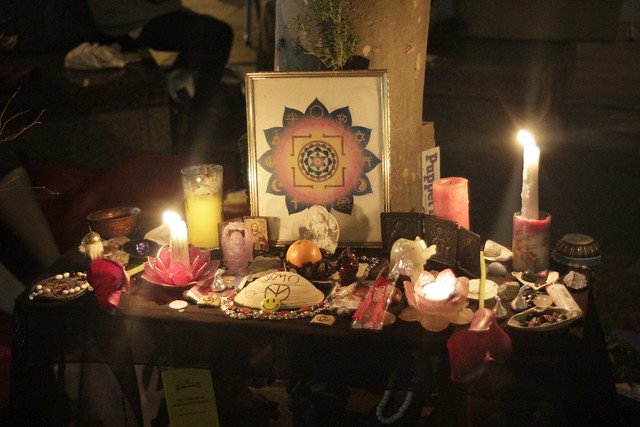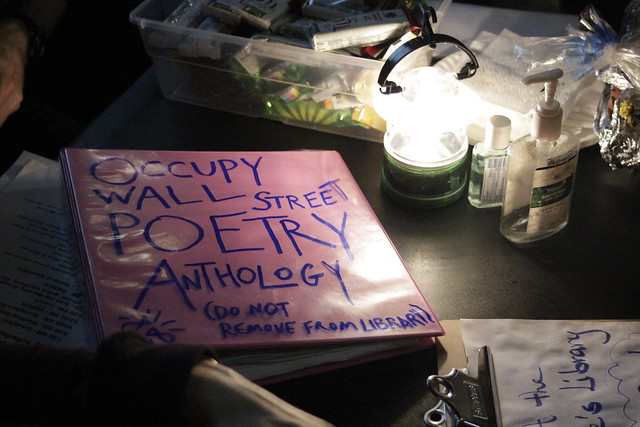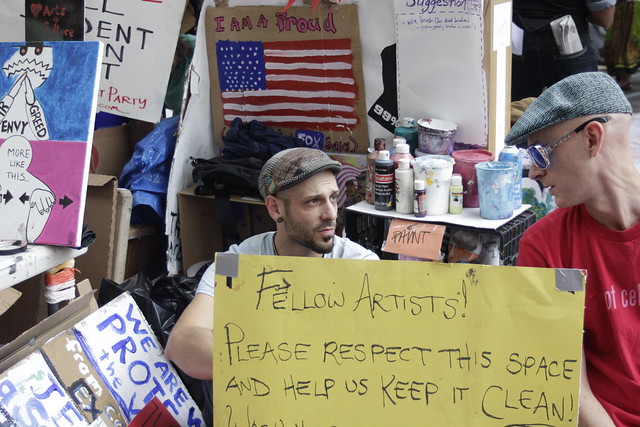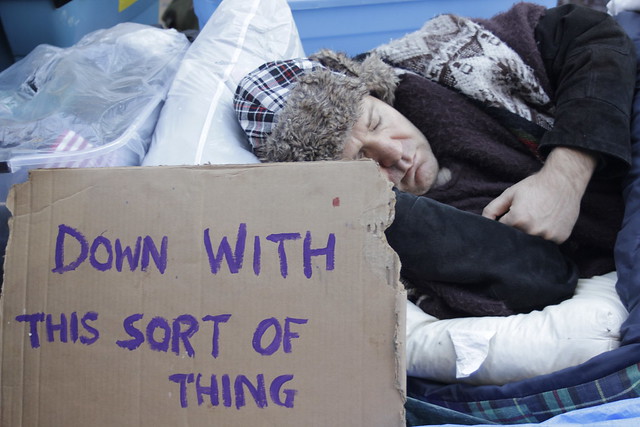Today's NYTimes has an insightful, appreciative, eminently non-trollish article on OWS, by architecture critic Michael Kimmelman. The intro gives you a good idea of the general tone of the article
THE ever expanding Occupy Wall Street movement, with encampments now not only in Lower Manhattan but also in Washington, London and other cities, proves among other things that no matter how instrumental new media have become in spreading protest these days, nothing replaces people taking to the streets.
Not bad, for starters. More below.
Kimmelman hits on a few things I'd thought while down at OWS, particularly the small-scale, intensive, and site-specific nature of the movement. Like me, he thinks of Aristotle's Politics:
I thought of Aristotle, of all people, while I watched the Zuccotti Park demonstrators hold one of their “general assemblies” the other day. In his “Politics,” Aristotle argued that the size of an ideal polis extended to the limits of a herald’s cry. He believed that the human voice was directly linked to civic order. A healthy citizenry in a proper city required face-to-face conversation.
OWS is helping to create something shockingly new in part because it's so shockingly old: direct, participatory governance, on the model of the old Greek polis, a politics of place, of community, of people who know each other and inhabit, or Occupy, the same space. And like any functioning polis, it reproduces all of the structural aspects of a city, in miniature:
It produces the outlines of a city, as I said. The protesters have set up a kitchen, for serving food, a legal desk and a sanitation department, a library of donated books, an area where the general assembly meets, a medical station, a media center where people can recharge their laptops using portable generators, and even a general store, called the comfort center, stocked with donated clothing, bedding, toothpaste and deodorant — like the food, all free for the taking.
Many of us here already know this, of course, but it's so incredibly refreshing to have these facts acknowledged by someone in the mainstream, and without the reservations, concerns, thinly-veiled critique, or outright dismissiveness that plagues so much of the NYTimes' coverage.
This is a movement about spaces, after all, be it the shrine at the northwest corner of the park, centered around a tree (Ygdrassil?), and encircled by a ring of stone benches
or the library at the northeast corner, OWS's archive of texts and lending library (and home of its poetry anthology, which I've yet to look into)
or the artists' and other spaces (counseling, coaching, etc.) all on the north side (note the "Respect the space" on the sign, a key idea for OWS)
or the sleeping quarters throughout the park
all the space is necessary, and all of it is used. A further testament to the resiliency and craftiness of OWS.
As Kimmelman notes, OWS is also about occupying virtual space:
The protesters’ diversity, at least during the day, is intrinsic to the protest’s resilience. Not since 9/11 have so many people been asking “Have you been there?” “Have you seen it?” about anyplace in Manhattan. The occupation of the virtual world along with Zuccotti Park is of course jointly propelling the Occupy Wall Street movement now, and neither would be so effective minus the other.
And, indeed, we see how quickly OWS transmutes one space to the other: I take a quick MTA trip to Liberty, say, walk around the space, photograph, and, voila, the real becomes virtual, and zaps around the world, to fill thousands of real spaces with images of OWS. And then maybe someone sees one of these images, and decides to make a pilgrimage down to OWS, to occupy their own version of Liberty Square, maybe take some pictures, talk with people, perhaps even take this media away and circulate it in their own fashion. The processes keep interchanging and interpenetrating, all of them focused, like a bullseye, on the common ground OWS is building, together. A mandala of protest, sacred precinct of democracy, a new city. Not the Puritan city on the hill, but definitely, these days at least, the Light of the World: a hopeful, forwardlooking, progressive community in the belly of the corporate beast. Come down and take a look, and we'll Occupy, even for a little bit, Together.
So thanks, Michael Kimmelman. If only more articles like yours could Occupy the pages of the Times.
9:10 AM PT: And I just read this lovely op-ed at the NYTimes, by Jerold S. Kayden, on how to go about reclaiming public spaces that are currently privatized.
What did they slip into the drinking water this morning over at the Grey Lady? Man, next we'll be hearing that us dirty OWS hippies have levitated the NYTimes building!
9:24 AM PT: Also, I can't recommend enough, as a primer to OWS's spaces, temporary spaces in general, and twenty-first-century architecture and built environments, Charlie Hailey's masterful, learned, and lavishly-illustrated Camps: A Guide to 21st-Century Space, which has informed so much of my experiences at OWS. A small excerpt, from the "Protest Camp" section:
Opposition to control defines the autonomy of the protest camp. Corollaries to walks, marches, and sit-ins, such camps provide a duration to sometimes fleeting expressions of opposition. As a communal space of autonomy, the protest camp provides visibility to a group's message and at the same time affords a chhesiveness that partially insulates its members from public exposure. . . . Protest camps are often event-specific. In other cases, they are reactions to long-standing policies or ideologies.
Prophetic text, published in 2009. Worth looking into, liberal exceprts available at the Google Books thingy.



